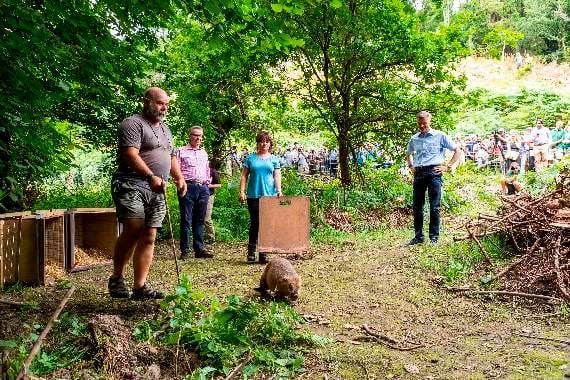AN animal unseen in the Dean for 400 years has made a comeback this week in an attempt to reduce local flooding.
A pair of Eurasian beavers, described as nature’s “natural habitat engineers,” was released yesterday (Tuesday, July 24) into a 6.5 hectare area around the Greathough Brook in Lydbrook.
Kevin Stannard, the Forestry Commission’s forest management director for the West England forest district, said: “Today’s release is a momentous occasion for the Forest of Dean. We are looking forward to seeing the ecological and hydrological benefits the beavers will bring to the Greathough Brook.
“We expect the beavers’ activity will improve biodiversity in their new home and may have the potential to reduce local flood risk.”
The Forestry Commission unveiled plans for a trial reintroduction into the Greathough Brook in March 2017. Since then, Natural England granted Forestry Commission officials a licence to release beavers into a carefully chosen and secure site which is now being used to house the semi-aquatic mammals.
Forestry Commission’s head of planning and environment for the district, Rebecca Wilson, said:“Beavers are natural habitat engineers, restoring complex wetland habitats and providing habitat for declining species while slowing the flow of water downstream. We are delighted to welcome beavers to the Forest and are keen to observe the many benefits they will bring to both local communities and the wider Forest of Dean environment.
“Hydrologists from the University of Exeter are undertaking research into the impacts of beaver reintroduction at a number of sites in the UK, including this one. Hydrological and ecological monitoring on the site is producing valuable scientific data and work is underway to ensure this informs future reintroductions.”
The release was attended by Environment Secretary, Michael Gove, who said: “The beaver has a special place in English heritage and the Forest of Dean. This release is a fantastic opportunity to develop our understanding of the potential impacts of reintroductions and help this iconic species, 400 years after it was driven to extinction.
“The community of Lydbrook has shown tremendous support for this scheme.”





Comments
This article has no comments yet. Be the first to leave a comment.